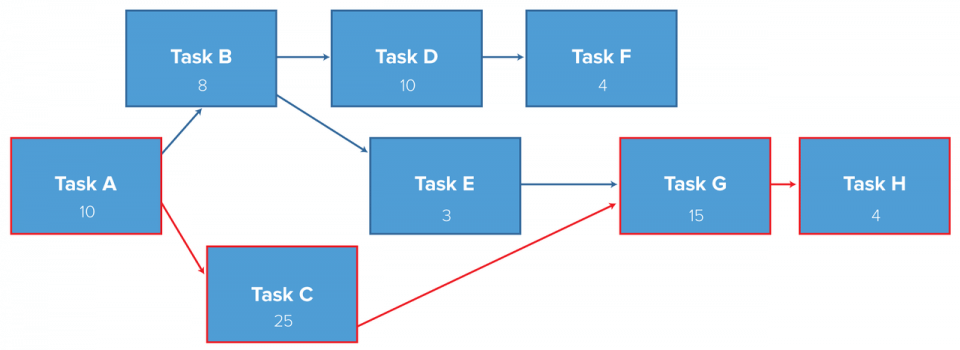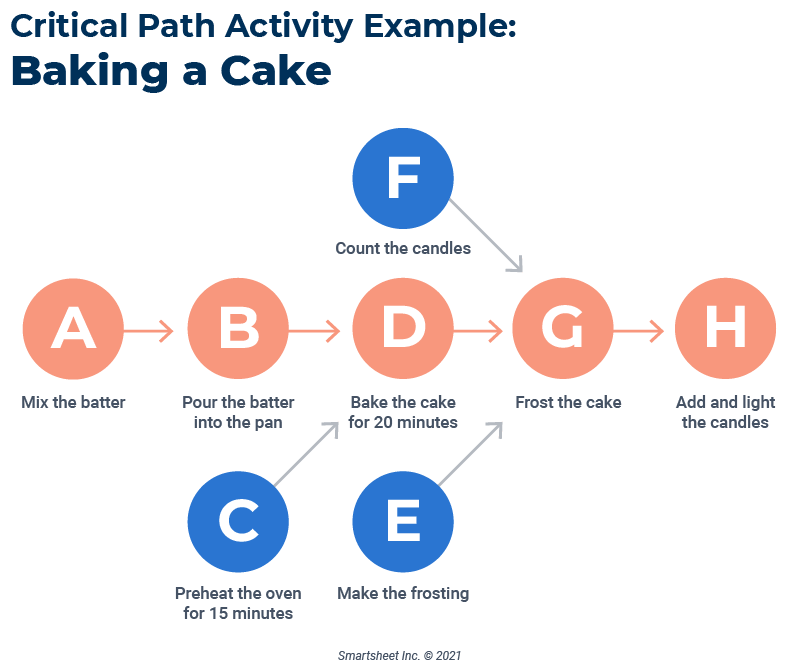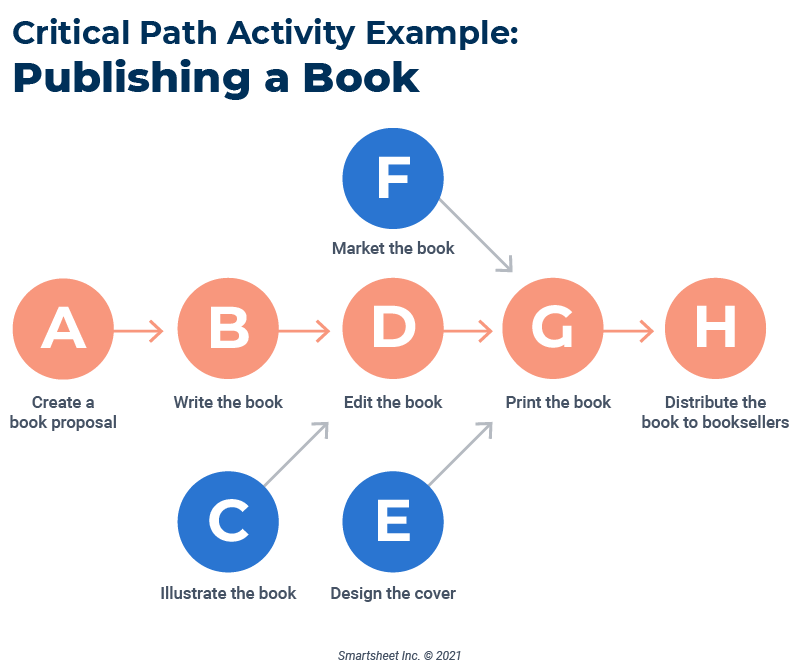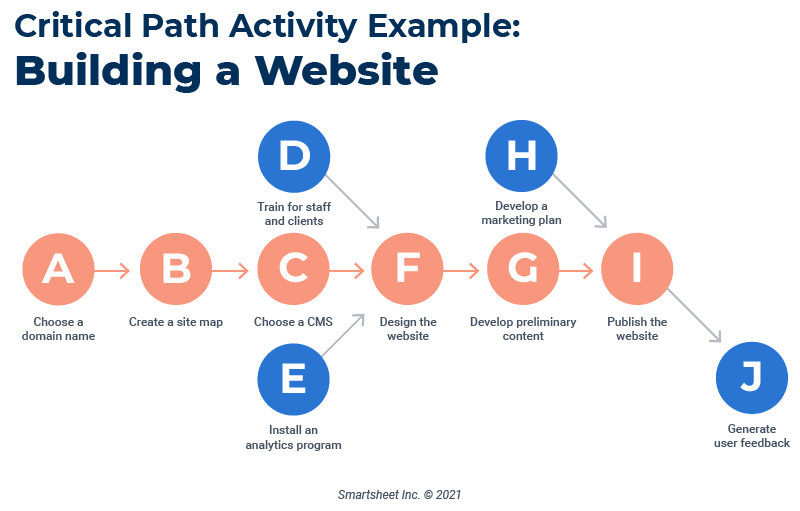What Is Critical Path?
A critical path in project management is the longest possible sequence of dependent tasks that stakeholders must complete on time in order to deliver a project on schedule. By identifying the critical path, you can determine the earliest project completion date.
Essentially, locating the longest sequence of dependencies allows you to find the shortest project duration. Read our guide to the critical path method to learn more about this practice.
“Critical activities are those that will delay the overall project duration, whereas non-critical activities won't delay a project,” said Thomas Jepsen, CEO of home-building platform Passion Plans. “Because of the nature of non-critical activities, you are more free to choose when to start a non-critical activity.”
Project Management Guide
Your one-stop shop for everything project management

Ready to get more out of your project management efforts? Visit our comprehensive project management guide for tips, best practices, and free resources to manage your work more effectively.
What Is a Critical Activity in Project Management?
A critical activity in project management is any task that stakeholders must complete on schedule to meet project deadlines. Delays in one activity will affect subsequent tasks and the entire project unless you can reduce the time on other tasks.
The terms critical activity and critical task are often used interchangeably in project management. There are two types of critical activities:
- Dependent Tasks: This category includes any activities you must complete in a certain order. A predecessor task must start or finish in order for the successor task to start or finish. Dependent tasks are sometimes referred to as sequential activities.
As an example, suppose you’re baking a birthday cake. Preheating the oven, baking the cake, and frosting the cake are all dependent tasks because each depends on the completion of the preceding tasks. - Parallel Tasks: You can run these activities concurrently with other tasks. To use the cake example, preheating the oven and mixing the cake batter could be parallel tasks because you can do them simultaneously. One does not depend on the other to start the task.
The concept of resource constraints, or the limitations on resources you have available for a certain project, is important to understanding critical activity and critical path. Examples of resource constraints include staff hours, budget, equipment, and supplies. More resource constraints result in more dependencies, which lengthen the critical path.
Suppose you’re hosting a dinner party without any assistance. If you’re preparing a main course and a dessert that will each take an hour and you can make only one dish at a time, these tasks become dependencies because they’re constrained by your time. The availability of your kitchen equipment may be another constraint.
But if you enlist a friend to bring dessert, you turn the two responsibilities into parallel tasks. By reducing the constraints on time and kitchen space, you’ve shortened the critical path.
Why Are Critical Path Activities Important?
Critical path activities are often important because they can throw the entire project off schedule. The key distinction between critical vs. non-critical activities is whether a late start or finish will push back the project completion date.
For example, a task may be an important part of a project, but it isn’t considered a critical activity unless completing it late will delay the entire project.
How Do Activities Work in a Critical Path Project Schedule?
Most projects include both dependent and parallel tasks. To develop a schedule, project managers typically identify the following for each activity:
- Earliest Start Date: Identify this date based on the amount of time it would take to complete the dependent tasks immediately preceding it.
- Earliest Finish Date: Assess the minimum amount of time needed to complete the task, and calculate this date based on the projected start date.
- Latest Start Date: Determine the latest date an activity can begin without jeopardizing the project schedule.
- Latest Finish Date: This is the latest date you can complete a task without pushing back the overall project timeline.
Project managers assign each task a float (also referred to as slack), which is the amount of time the task can be delayed without impacting the project schedule. Activities on the critical path will have zero float.
CPM works best when there’s a high level of certainty about how long critical path activities will take to complete. When project managers aren’t sure of the duration of some tasks, they’ll often use CPM in tandem with the project analysis and review technique (PERT), another approach to project management.
In PERT, you calculate three durations: the optimistic duration, the most likely duration, and the pessimistic duration. Using a weighted average of the three durations, PERT creates an estimated duration.
How Do You Find Critical Activities?
Before you apply the critical path method, you’ll need to have a well-defined project scope. Use a critical path tracking template to help you plan and adjust the project schedule.
Once you’ve established the goals, budget, and schedule, these following six steps can help you find critical activities in CPM:
- Divide the Project into Tasks: Break down the project into basic activities, keeping a high-level focus. From there, break down activities into more detailed subtasks, then use a work breakdown structure (WBS) to arrange activities further into manageable pieces of work.
- Establish Dependencies: To establish dependencies among tasks, ask yourself the following questions for each task:
- What tasks need to be completed before this task begins?
- What tasks can be completed at the same time as this task?
- What task should begin immediately after this task is completed?
- Create the Critical Path Analysis Chart: The critical path analysis (CPA) chart, also known as the network diagram, visually represents activities and their dependencies. Once you’ve established activities and dependencies, you can create your critical path analysis chart, either by drawing it by hand or using software. You can also create a Gantt chart for the critical path for a timeline view of projects and their dependencies.
- Estimate Completion Time for Each Activity: Estimate the amount of time you believe each activity will require. Project managers often use scheduling software to set a realistic timeframe for task duration, and to identify places to reduce the duration of critical activities in CPM.
To create a realistic schedule, many project managers estimate completion time using the following three-point system:- Best-case scenario, or shortest time frame
- Most likely scenario, or most realistic time frame
- Worst-case scenario, or longest time frame
Seek feedback when scheduling tasks using CPM.
“Reviewing your critical activities with key stakeholders is crucial,” says Jepsen. “While the underlying ideas may be rather simple to follow in a diagram, it's important to understand that you're working with human beings. In the real world, you're operating in a dynamic situation where initial project detail assumption may not hold. Perhaps your main engineer falls sick. What do you do then?”
- Identify the Critical Path: There are two ways to identify the critical path:
- Use your network diagram and draw the longest path through the network.
- Use the forward pass/backward pass method, in which you identify the earliest start and finish times, along with the latest start and finish times.
- Update the Critical Path Diagram Throughout the Project: As the team completes activities over the course of the project, update your diagram to show the actual time for completion rather than your projections. Doing so will help you create a more realistic schedule as the project progresses and, possibly, identify a new critical path.
Examples of Critical Path Activities
These examples demonstrate easy visual examples of critical path activities/tasks versus non-critical path activities/tasks. We’ve broken out the tasks that must happen in a particular sequence (critical) vs. those that don’t (non-critical).
Example #1: Baking a Birthday Cake
Critical activities:
- Mix the batter (A)
- Pour the batter into the pan (B)
- Bake the cake for 20 minutes (D)
- Frost the cake (G)
- Add and light the candles (H)
Non-critical activities:
- Preheat the oven for 15 minutes (C)
- Make the frosting (E)
- Count the candles (F)
A: Mixing the batter
B: Pouring the batter into the pan
C: Preheating the oven for 15 minutes
D: Baking the cake for 20 minutes
E: Making the frosting
F: Counting the candles
G: Frosting the cake
H: Adding and lighting the candles
The critical path for baking a cake is A, B, D, G, H.
Example #2: Publishing a Book
Critical activities:
- Create a book proposal (A)
- Write the book (B)
- Edit the book (D)
- Print the book (G)
- Distribute the book to booksellers (H)
Non-critical activities:
- Illustrate the book (C)
- Design the cover (E)
- Market the book (F)
The critical path for publishing a book is A, B, D, G, H.
Example #3: Building a Website
Critical activities:
- Choose a domain name (A)
- Create a site map (B)
- Choose a CMS (C)
- Design the website (F)
- Develop preliminary content (G)
- Publish the website (I)
Non-critical activities:
- Train for staff and clients (D)
- Install an analytics program (E)
- Develop a marketing plan (H)
- Generate user feedback (J)
The critical path for building a website is A, B, C, F, G, I.
What Is a Crashing Activity in Critical Path?
A crashing activity in critical path management is a strategy of adding resources to an activity, potentially resulting in a new critical path. Project managers may use crashing to speed up the timeline or when a project is behind schedule.
For example, if a storm delays a critical task in a construction project, you may crash an activity by hiring additional contractors, reallocating staff who are working on a different activity or project, or paying overtime to stay on schedule.
An alternative to project crashing is fast tracking, in which the team completes activities in parallel. Project managers typically use crashing after fast tracking has failed.
Critical Activities vs. Critical Path
A project’s critical activities are those that have zero float, meaning any delay in completion delays the entire project. In contrast, the critical path maps the longest path through all critical activities from start to finish in a project.
Returning to the cake-baking example, mixing the cake batter and baking the cake are activities with zero float. Any delay in either task would delay the completion of the cake.
For a real-world example in project management, suppose you are obtaining permits for a construction project. You need to obtain permits to begin site work, so if permitting takes longer than you expected, the entire project schedule will be thrown off track.
As an example of critical activities, say you are planning an event budget. Until you make the budget, you can’t book a venue, sign contracts with vendors, or market the event.
What Is a Critical Task in Project Management?
A critical task in project management is an activity that must be completed on schedule to avoid delaying a project. This is the same as a critical activity.
What Are Critical Flags in a Critical Path?
A critical flag is a mark applied to tasks that you deem critical using project management software. You can apply a critical flag to a task if it affects the duration of the overall project. Otherwise, the task is considered non-critical.
When to Apply a Critical Flag to an Activity or Task
Apply a critical flag to any task with a total float of zero or a negative float, which occurs when a task’s schedule must be compressed in order to complete the project on time.
Project managers will often create multiple critical paths during a project because delays may make tasks that were originally non-critical activities into critical activities. It’s essential that you closely monitor critical tasks, along with any linked non-critical tasks that are at risk of becoming critical.
Track and Manage Critical Path Activities with Smartsheet for Project Management
From simple task management and project planning to complex resource and portfolio management, Smartsheet helps you improve collaboration and increase work velocity -- empowering you to get more done.
The Smartsheet platform makes it easy to plan, capture, manage, and report on work from anywhere, helping your team be more effective and get more done. Report on key metrics and get real-time visibility into work as it happens with roll-up reports, dashboards, and automated workflows built to keep your team connected and informed.
When teams have clarity into the work getting done, there’s no telling how much more they can accomplish in the same amount of time. Try Smartsheet for free, today.



